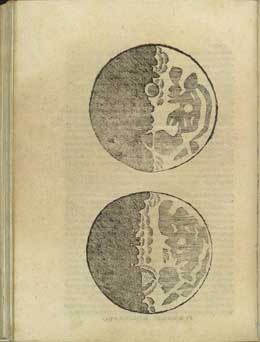Highlights

GALILEI, Galileo (1564-1642)
Sidereus nuncius magna, longeque admirabilia
spectacula pandens.
Venice: Tommaso Baglioni, 1610.
 F
F
irst edition of the foundation work of modern astronomy containing the first account of astronomical discoveries made with the telescope. Having learned from
Paolo Sarpi in 1609 of the invention by Hans Lipperhey of a device for making distant objects appear closer, Galileo set out to construct his own instrument. Within a few months he had improved his first nine-power instrument to one of about thirty-power, the practicable limit for a telescope of that type (with plano-convex objective and plano-concave eyepiece). He first turned his telescope to the heavens in early January 1610 with startling results. Not only was the moon revealed to be mountainous and the Milky Way to be a congeries of separate stars, contrary to Aristotelian principles, but a host of new fixed stars and four satellites of Jupiter [which he named the Medicea Sidera in honour of Cosimo II de' Medici] were promptly discovered. Working with great haste but impressive accuracy, Galileo recited these discoveries in the Sidereus nuncius, published at Venice early in March 1610. Galileo's discoveries, which won him instant fame, did not prove that Copernicus was correct, only that the Aristotelian-Ptolemaic view of the universe was utterly false. Nowhere in the Sidereus nuncius did Galileo explicitly express his private views in support of heliocentrism. Nevertheless, the work was immediately the object of virulent attacks, which questioned the reality of rather than the implications of his observations.
The reliability of the telescope, rather than the philosophical or theological plausibility of the Copernican system, was the main target of Galileo's adversaries and the subject of his replies in the period immediately following the publication of the Sidereus nuncius. Galileo's defence against these attacks was to legitimize his discoveries by linking them to his Medici patrons, not only through the dedication of his work to Cosimo II and his naming of the "Medicean stars," but more pointedly through his use of the Medicean diplomatic network to distribute telescopes and copies of his work to the European princes and cultural elite. The debate on Copernicanism was, however, reignited by this epochal work, the opening salvo of the assault of modern astronomy on the medieval view of the cosmos.

